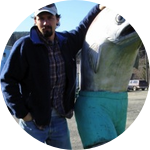About This Project
In 2008, Dr. Christian Sidor’s team discovered the bones of a Triceratops in Wyoming. Those bones included a jaw bone, vertebra and part of a skull, but his team decided not to collect the bones at that time. This summer Dr. Sidor's team will not only collect the bones they left, they’ll attempt to bring back an entire skeleton to the Burke Museum in Seattle. Dr. Sidor has been on dig expeditions on six of the seven continents.Ask the Scientists
Join The DiscussionWhat is the context of this research?
Paleontology doesn’t get funding. The vertebrate paleontology collection at the Burke consists of about 50,000 specimens. Of these, about 90% are fossil mammals, so dinosaurs and other fossil reptiles are greatly underrepresented in our collection. This means that our displays aren't are good as they could be, but also that I'm limited in what I can use in the lab of my paleontology classes.
What is the significance of this project?
This project has the potential to generate a tremendous legacy. Triceratops is an iconic dinosaur and the Burke Museum would love to have a more complete specimen on display. Beyond the public aspect of the project, dinosaur fossils are used in a number of classes at the UW, so additional Triceratops material would be used for years to come while we train undergraduates and graduates in paleontology, evolution, and the history of the Earth.
What are the goals of the project?
First, we will apply for an excavation permit from the Bureau of Land Management. This special permit is necessary because the Triceratops is on public land. We plan to excavate over an area of approximately 150 square feet (10' x 15'). Once we have the permit, we will head out to Wyoming with a group including Burke Museum staff, museum volunteers, as well as graduate and undergraduate students in paleontology. Depending on how complete the skeleton turns out to be, the dig could take between 1-3 weeks. Once the skeleton is back at the lab, preparing it for display will take a lot longer!
Budget
We will use the funds to compile a Triceratops skeleton complete enough to put on display. This would be a 100% success for this project.
Meet the Team
Affiliates
University of Washington, Professor
University of Chicago, M.S., Ph.D Organismal Biology
Trinity College, B.S. Biology
Team Bio
Dr. Christian Sidor is the Curator of Vertebrate Paleontology at the Burke Museum of Natural History and a Professor in the Department of Biology at the University of Washington. He earned his Ph.D. and M.S. in Organismal Biology and Anatomy at the University of Chicago and his B.S. in Biology at Trinity College.Interested in learning more about Dr. Sidor? Click here.
Christian Sidor
Dr. Christian Sidor is the Curator of Vertebrate Paleontology at the Burke Museum of Natural History and a Professor in the Department of Biology at the University of Washington. He earned his Ph.D. and M.S. in Organismal Biology and Anatomy at the University of Chicago and his B.S. in Biology at Trinity College.
Interested in learning more about Dr. Sidor? Click here.
Brandon Peecook
I am a paleontologist at the Field Museum in Chicago, and National Geographic Explorer. My work focuses on mass extinctions and the early evolution of important groups like dinosaurs, crocodiles, and mammals. Most of my research takes place in Zambia, but I also work in Antarctica and around the USA in Arizona and Montana.
I am a born-and-raised Michigander and have been fascinated with the natural world all my life. As a child I loved the outdoors, and my dinosaurs, and it was when I was in middle school when I first began to understand the explanatory power of evolution. "You mean evolution connects the dinosaurs in my books with the woods in my yard?!" I've never looked back.
Additional Information
Relevant Publications
Huttenlocker, AK, CA Sidor, and RMH Smith. A new specimen of Promoschorhynchus (Therapsida: Therocephalia: Akidnognathidae) from the Early Triassic of South Africa and its implications for theriodont survivorship across the Permo-Triassic boundary. Journal of Vertebrate Paleontology 31:405-421.Tabor, NJ, RMH Smith, JS Steyer, CA Sidor, and CJ Poulsen. The Permian Moradi Formation of northern Niger: paleosol morphology, petrography and mineralogy. Palaeogeography, Palaeoclimatology, Palaeoecology 299:200-213.
Nesbitt, SJ, CA Sidor, RB Irmis, KD Angielczyk, RMH Smith, and LA Tsuji. 2010. Ecologically distinct dinosaurian sister group shows early diversification of Ornithodira. Nature 464: 95-98.
Project Backers
- 35Backers
- 104%Funded
- $2,395Total Donations
- $68.43Average Donation


